formerly eScholarship Editions


|
|
|
|
Your search for
'California and the West' in subject
found 104 book(s). | Modify Search | Displaying 61 - 80 of 104 book(s) | |
| 61. | 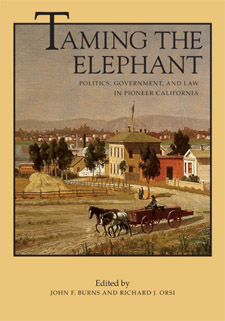 | Title: Taming the elephant: politics, government, and law in pioneer California Author: Burns, John F Published: University of California Press, 2003 Subjects: History | Californian and Western History | United States History | California and the West Publisher's Description: Taming the Elephant is the last of four volumes in the distinguished California History Sesquicentennial Series, an outstanding compilation of original essays by leading historians and writers. These topical, interrelated volumes reexamine the meaning of the founding of modern California during the state's pioneer period. General themes run through all four volumes: the interplay of traditional cultures and frontier innovation in the creation of a distinctive California society; the dynamic interaction of people and nature and the beginnings of massive environmental change; the impact of the California experience on the nation and the world; the influence of pioneer patterns on modern California; and the legacy of ethnic and cultural diversity as a major influence on the state's history. This fourth volume treats the role of post-Gold Rush California government, politics, and law in the building of a dynamic state, with influences that persist today. Provocative essays investigate the creation of constitutional foundations, law and jurisprudence, the formation of government agencies, and the development of public policy. Authors chart the roles played by diverse groups - criminals and peace officers, entrepreneurs and miners, farmers and public officials, defenders of discrimination and female and African American activists. The essays also explore subjects largely overlooked in the past, such as the significance of local and federal government in pioneer California and early struggles to secure civil rights for women and racial minorities. [brief] Similar Items |
| 62. | 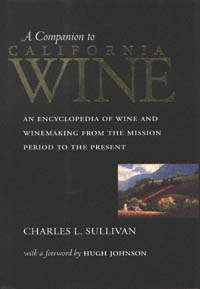 | Title: A companion to California wine: an encyclopedia of wine and winemaking from the mission period to the present Author: Sullivan, Charles L. (Charles Lewis) 1932- Published: University of California Press, 1998 Subjects: Viticulture | California and the West | Californian and Western History | Wine Publisher's Description: California is the nation's great vineyard, supplying grapes for most of the wine produced in the United States. The state is home to more than 700 wineries, and California's premier wines are recognized throughout the world. But until now there has been no comprehensive guide to California wine and winemaking. Charles L. Sullivan's A Companion to California Wine admirably fills that gap - here is the reference work for consumers, wine writers, producers, and scholars.Sullivan's encyclopedic handbook traces the Golden State's wine industry from its mission period and Gold Rush origins down to last year's planting and vintage statistics. All aspects of wine are included, and wine production from vine propagation to bottling is described in straightforward language. There are entries for some 750 wineries, both historical and contemporary; for more than 100 wine grape varieties, from Aleatico to Zinfandel; and for wine types from claret to vermouth - all given in a historical context.In the book's foreword the doyen of wine writers, Hugh Johnson, tells of his own forty-year appreciation of California wine and its history. "Charles Sullivan's Companion ," he adds, "will provide the grist for debate, speculation, and reminiscence from now on. With admirable dispassion he sets before us just what has happened in the plot so far." [brief] Similar Items |
| 63. | 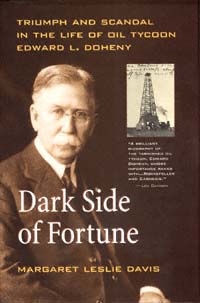 | Title: Dark side of fortune: triumph and scandal in the life of oil tycoon Edward L. Doheny Author: Davis, Margaret L Published: University of California Press, 1998 Subjects: History | California and the West | American Studies | Cultural Anthropology | Autobiographies and Biographies Publisher's Description: Dark Side of Fortune contains all the elements of a Hollywood thriller. Filling in one of the most important gaps in the history of the American West, Margaret Leslie Davis's riveting biography follows Edward L. Doheny's fascinating story from his days as an itinerant prospector in the dangerous jungles of Mexico, where he built the $100-million oil empire that ushered in the new era of petroleum. But it was a tale that ended in tragedy, when - at the peak of his economic power - Doheny was embroiled in the notorious Teapot Dome scandal and charged with bribing the U.S. Secretary of the Interior.Few captains of industry have matched Doheny's drive to succeed and his far-reaching ambition. Drawn to the West in search of fortune, he failed at prospecting before finding oil in a smelly, tar-befouled lot in Los Angeles in 1892. Certain that the substance had commercial value, he envisioned steamships and locomotives no longer powered by coal, but by oil. After developing massive oil wells in Mexico, Doheny built an international oil empire that made him one of the wealthiest men in the world. But in 1924 the scandal of Teapot Dome engulfed him. As accusations mounted, he hired America's top legal talent for his defense. During the ten-year-long litigation, Doheny's only son was mysteriously murdered by a family confidant. The government's case against Doheny ended in an astounding jury decision: The cabinet official accused of taking a bribe from Doheny was found guilty and sent to prison, yet Doheny was fully acquitted. Despite the verdict, the scandal had overshadowed the achievements of a lifetime, and he died in disgrace in 1935.Margaret Leslie Davis recreates the legal drama and adds details of behind-the-scenes strategy gleaned from the personal diaries and archives of Doheny's famed defense attorneys. Previously hidden personal correspondence adds to this first complete portrait of the man and answers questions about Doheny that have eluded historians for almost seventy-five years. [brief] Similar Items |
| 64. | 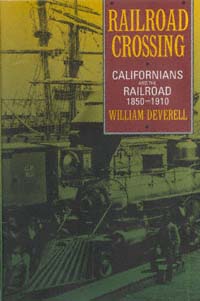 | Title: Railroad crossing: Californians and the railroad, 1850-1910 Author: Deverell, William Francis Published: University of California Press, 1994 Subjects: History | California and the West | United States History | Californian and Western History Publisher's Description: Nothing so changed nineteenth-century America as did the railroad. Growing up together, the iron horse and the young nation developed a fast friendship. Railroad Crossing is the story of what happened to that friendship, particularly in California, and it illuminates the chaos that was industrial America from the middle of the nineteenth century through the first decade of the twentieth.Americans clamored for the progress and prosperity that railroads would surely bring, and no railroad was more crucial for California than the transcontinental line linking East to West. With Gold Rush prosperity fading, Californians looked to the railroad as the state's new savior. But social upheaval and economic disruption came down the tracks along with growth and opportunity.Analyzing the changes wrought by the railroad, William Deverell reveals the contradictory roles that technology and industrial capitalism played in the lives of Americans. That contrast was especially apparent in California, where the gigantic corporate "Octopus" - the Southern Pacific Railroad - held near-monopoly status. The state's largest employer and biggest corporation, the S.P. was a key provider of jobs and transportation - and wielder of tremendous political and financial clout.Deverell's lively study is peopled by a rich and disparate cast: railroad barons, newspaper editors, novelists, union activists, feminists, farmers, and the railroad workers themselves. Together, their lives reflect the many tensions - political, social, and economic - that accompanied the industrial transition of turn-of-the-century America. [brief] Similar Items |
| 65. | 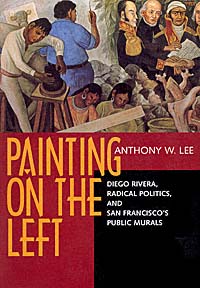 | Title: Painting on the left: Diego Rivera, radical politics, and San Francisco's public murals Author: Lee, Anthony W 1960- Published: University of California Press, 1999 Subjects: Art | Art History | Californian and Western History | California and the West Publisher's Description: The boldly political mural projects of Diego Rivera and other leftist artists in San Francisco during the 1930s and early 1940s are the focus of Anthony W. Lee's fascinating book. Led by Rivera, these painters used murals as a vehicle to reject the economic and political status quo and to give visible form to labor and radical ideologies, including Communism.Several murals, and details of others, are reproduced here for the first time. Of special interest are works by Rivera that chart a progress from mural paintings commissioned for private spaces to those produced as a public act in a public space: Allegory of California, painted in 1930-31 at the Stock Exchange Lunch Club; Making a Fresco, Showing the Building of a City , done a few months later at the California School of Fine Arts; and Pan American Unity , painted in 1940 for the Golden Gate International Exposition.Labor itself became a focus of the new murals: Rivera painted a massive representation of a construction worker just as San Francisco's workers were themselves organizing; Victor Arnautoff, Bernard Zakheim, John Langley Howard , and Clifford Wight painted panels in Coit Tower that acknowledged the resolve of the dockworkers striking on the streets below. Radical in technique as well, these muralists used new compositional strategies of congestion, misdirection, and fragmentation, subverting the legible narratives and coherent allegories of traditional murals.Lee relates the development of wall painting to San Francisco's international expositions of 1915 and 1939, the new museums and art schools, corporate patronage, and the concerns of immigrants and ethnic groups. And he examines how mural painters struggled against those forces that threatened their practice: the growing acceptance of modernist easel painting, the vagaries of New Deal patronage, and a wartime nationalism hostile to radical politics. [brief] Similar Items |
| 66. | 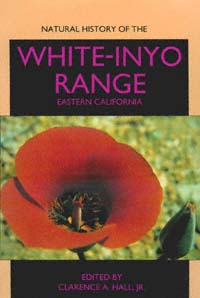 | Title: Natural history of the White-Inyo Range, eastern California Author: Hall, Clarence A Published: University of California Press, 1991 Subjects: Environmental Studies | Ecology | Earth Sciences | California and the West | Natural History Publisher's Description: The White-Inyo Range - rising sharply from the eastern edge of Owens Valley - is one of the most extraordinary landscapes in the world. High, dry, and amazingly diverse, it boasts an expansive alpine tundra and features the oldest living species on earth - the 4,000-year-old Bristlecone Pines. This colorful and authoritative volume assembles a wealth of information of deep interest to the hikers and scientists attracted to White-Inyo's altitude and isolation.The nearly two dozen contributors to the volume are leading experts on the flora and fauna, the geology, geomorphology, meteorology, anthropology, and archaeology of the area. The book offers descriptions of more than 650 kinds of living organisms, from the handful of fish to the abundance of reptile, amphibian, bird and plant species. (It provides descriptions of hundreds of flowering plants.) It contains an 8-color geologic map and a roadside guide that enables the visitor to make sense of the area's complex geological history. Readers will also learn about air currents that make the range a delight for sailplane pilots and create strange cloud formations. And a special chapter tells what is known of the Native Americans who moved up and down the mountain slopes in response to seasonal changes.For anyone who wishes to visit this astonishing area or to do research there, this volume will be a unique, comprehensive resource. [brief] Similar Items |
| 67. | 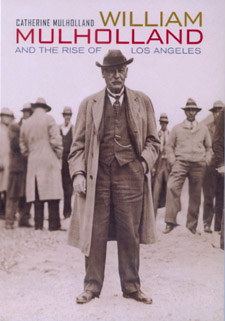 | Title: William Mulholland and the rise of Los Angeles Author: Mulholland, Catherine 1923- Published: University of California Press, 2000 Subjects: History | California and the West | Californian and Western History | Autobiographies and Biographies Publisher's Description: William Mulholland presided over the creation of a water system that forever changed the course of southern California's history. Mulholland, a self-taught engineer, was the chief architect of the Owens Valley Aqueduct - a project ranking in magnitude and daring with the Panama Canal - that brought water to semi-arid Los Angeles from the lush Owens Valley. The story of Los Angeles's quest for water is both famous and notorious: it has been the subject of the classic yet historically distorted movie Chinatown, as well as many other accounts. This first full-length biography of Mulholland challenges many of the prevailing versions of his life story and sheds new light on the history of Los Angeles and its relationship with its most prized resource: water. Catherine Mulholland, the engineer's granddaughter, provides insights into this story that family familiarity affords, and adds to our historical understanding with extensive primary research in sources such as Mulholland's recently uncovered office files, newspapers, and Department of Water and Power archives. She scrutinizes Mulholland's life - from his childhood in Ireland to his triumphant completion of the Owens Valley Aqueduct to the tragedy that ended his career. This vivid portrait of a rich chapter in the history of Los Angeles is enhanced with a generous selection of previously unpublished photographs. Los Angeles Times Best Nonfiction Book of 2000 [brief] Similar Items |
| 68. | 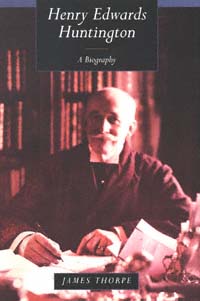 | Title: Henry Edwards Huntington: a biography Author: Thorpe, James Ernest 1915- Published: University of California Press, 1994 Subjects: History | California and the West | Californian and Western History | United States History | Autobiographies and Biographies Publisher's Description: A legendary book collector, a connoisseur of fine art, a horticulturist, and a philanthropist, Henry Edwards Huntington is perhaps best known as the founder of the world-renowned Huntington Library, Art Gallery, and Botanical Gardens in San Marino, California. James Thorpe's comprehensive biography of Huntington tells the richly human story of the man who became America's greatest book collector and was a leading figure in the development of southern California.Henry Edwards Huntington was born in New York State in 1850. He began working at the age of 17, eventually moved to California, and in later years was hailed for his vision in developing the street railway system that created the structure of the Los Angeles area. Always a lover of books, Huntington acquired many spectacular volumes - among them the complete Gutenberg Bible on vellum and the library of the Earl of Bridgewater. He also built a splendid art collection and established a grand botanical garden on the grounds of the buildings that would house his art and books. Then, in an act of philanthropy seldom equaled, he gave these great treasures to the public.The intimate side of Huntington's life appears in these pages, too. Thorpe has culled a vast trove of private letters, diaries, and other documents that reveal Huntington's exceptional personal qualities. The author's well-rounded biography of this unassuming yet gifted American is also richly evocative of the times in which Henry Edwards Huntington lived. [brief] Similar Items |
| 69. | 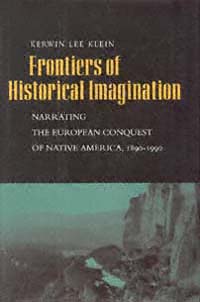 | Title: Frontiers of historical imagination: narrating the European conquest of native America, 1890-1990 Author: Klein, Kerwin Lee 1961- Published: University of California Press, 1997 Subjects: History | California and the West | American Studies | Anthropology | United States History | Intellectual History | Postcolonial Studies Publisher's Description: The American frontier, a potent symbol since Europeans first stepped ashore on North America, serves as the touchstone for Kerwin Klein's analysis of the narrating of history. Klein explores the traditions through which historians, philosophers, anthropologists, and literary critics have understood the story of America's origin and the way those understandings have shaped and been shaped by changing conceptions of history. The American West was once the frontier space where migrating Europe collided with Native America, where the historical civilizations of the Old World met the nonhistorical wilds of the New. It was not only the cultural combat zone where American democracy was forged but also the ragged edge of History itself, where historical and nonhistorical defied and defined each other. Klein maintains that the idea of a collision between people with and without history still dominates public memory. But the collision, he believes, resounds even more powerfully in the historical imagination, which creates conflicts between narration and knowledge and carries them into the language used to describe the American frontier. In Klein's words, "We remain obscurely entangled in philosophies of history we no longer profess, and the very idea of 'America' balances on history's shifting frontiers." [brief] Similar Items |
| 70. | 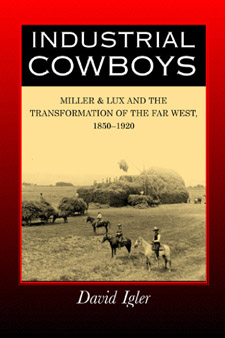 | Title: Industrial cowboys: Miller & Lux and the transformation of the Far West, 1850-1920 Author: Igler, David 1964- Published: University of California Press, 2001 Subjects: History | United States History | Californian and Western History | Environmental Studies | California and the West | Agriculture | Economics and Business Publisher's Description: Few industrial enterprises left a more enduring imprint on the American West than Miller & Lux, a vast meatpacking conglomerate started by two San Francisco butchers in 1858. Industrial Cowboys examines how Henry Miller and Charles Lux, two German immigrants, consolidated the West's most extensive land and water rights, swayed legislatures and courts, monopolized western beef markets, and imposed their corporate will on California's natural environment. Told with clarity and originality, this story uses one fascinating case study to illuminate the industrial development and environmental transformation of the American West during the late nineteenth and early twentieth centuries. The process by which two neighborhood butchers turned themselves into landed industrialists depended to an extraordinary degree on the acquisition, manipulation, and exploitation of natural resources. David Igler examines the broader impact that industrialism--as exemplified by Miller & Lux--had on landscapes and waterscapes, and on human as well as plant and animal life in the West. He also provides a rich discussion of the social relations engineered by Miller & Lux, from the dispossession of Californio rancheros to the ethnic segmentation of the firm's massive labor force. The book also covers such topics as land acquisition and reclamation, water politics, San Francisco's unique business environment, and the city's relation to its surrounding hinterlands. Above all, Igler highlights essential issues that resonate for us today: who holds the right and who has the power to engineer the landscape for market production? [brief] Similar Items |
| 71. | 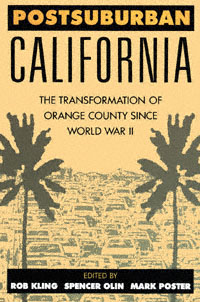 | Title: Postsuburban California: the transformation of Orange County since World War II Author: Kling, Rob Published: University of California Press, 1995 Subjects: History | Sociology | United States History | American Studies | California and the West | Urban Studies | Californian and Western History Publisher's Description: Neither a city nor a traditional suburb, Orange County, California represents a striking example of a new kind of social formation. This multidisciplinary volume offers a cogent case study of the "postsuburban" phenomenon. Similar Items |
| 72. | 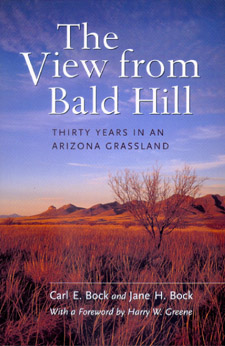 | Title: The view from Bald Hill: thirty years in an Arizona grassland Author: Bock, Carl E 1942- Published: University of California Press, 2000 Subjects: Environmental Studies | Conservation | California and the West | Ecology | Natural History | Science | Biology | Botany | Zoology Publisher's Description: In 1540 Francisco Vasquez de Coronado introduced the first domestic livestock to the American Southwest. Over the subsequent four centuries, cattle, horses, and sheep have created a massive ecological experiment on these arid grasslands, changing them in ways we can never know with certainty. The Appleton-Whittell Research Ranch in the high desert of southeastern Arizona is an 8,000-acre sanctuary where grazing has been banned since 1968. In this spirited account of thirty years of research at the ranch, Carl and Jane Bock summarize the results of their fieldwork, which was aimed at understanding the dynamics of grasslands in the absence of livestock. The View from Bald Hill provides an intimate look at the natural history of this unique site and illuminates many issues pertaining to the protection and restoration of our nation's grasslands. [brief] Similar Items |
| 73. | 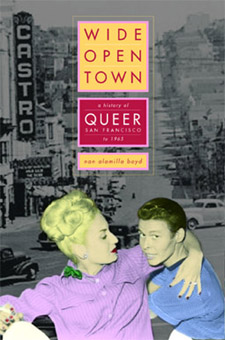 | Title: Wide-open town: a history of queer San Francisco to 1965 Author: Boyd, Nan Alamilla 1963- Published: University of California Press, 2003 Subjects: American Studies | Anthropology | GayLesbian and Bisexual Studies | Ethnic Studies | United States History | Sociology | California and the West Publisher's Description: Wide-Open Town traces the history of gay men and lesbians in San Francisco from the turn of the century, when queer bars emerged in San Francisco's tourist districts, to 1965, when a raid on a drag ball changed the course of queer history. Bringing to life the striking personalities and vibrant milieu that fueled this era, Nan Alamilla Boyd examines the culture that developed around the bar scene and homophile activism. She argues that the communities forged inside bars and taverns functioned politically and, ultimately, offered practical and ideological responses to the policing of San Francisco's queer and transgender communities. Using police and court records, oral histories, tourist literature, and manuscript collections from local and state archives, Nan Alamilla Boyd explains the phenomenal growth of San Francisco as a "wide-open town" - a town where anything goes. She also relates the early history of the gay and lesbian civil rights movement that took place in San Francisco prior to 1965. Wide-Open Town argues that police persecution forged debates about rights and justice that transformed San Francisco's queer communities into the identity-based groups we see today. In its vivid re-creation of bar and drag life, its absorbing portrait of central figures in the communities, and its provocative chronicling of this period in the country's most transgressive city, Wide-Open Town offers a fascinating and lively new chapter of American queer history. [brief] Similar Items |
| 74. | 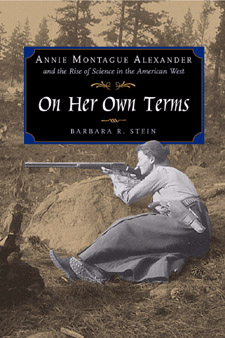 | Title: On her own terms: Annie Montague Alexander and the rise of science in the American West Author: Stein, Barbara R 1955- Published: University of California Press, 2001 Subjects: Autobiographies and Biographies | History of Science | Paleontology | California and the West | Women's Studies Publisher's Description: At a time when women could not vote and very few were involved in the world outside the home, Annie Montague Alexander (1867-1950) was an intrepid explorer, amateur naturalist, skilled markswoman, philanthropist, farmer, and founder and patron of two natural history museums at the University of California, Berkeley. Barbara R. Stein presents a luminous portrait of this remarkable woman, a pioneer who helped shape the world of science in California, yet whose name has been little known until now. Alexander's father founded a Hawaiian sugar empire, and his great wealth afforded his adventurous daughter the opportunity to pursue her many interests. Stein portrays Alexander as a complex, intelligent, woman who--despite her frail appearance--was determined to achieve something with her life. Along with Louise Kellogg, her partner of forty years, Alexander collected thousands of animal, plant, and fossil specimens throughout western North America. Their collections serve as an invaluable record of the flora and fauna that were beginning to disappear as the West succumbed to spiraling population growth, urbanization, and agricultural development. Today at least seventeen taxa are named for Alexander, and several others honor Kellogg, who continued to make field trips after Alexander's death. Alexander's dealings with scientists and her encouragement--and funding--of women to do field research earned her much admiration, even from those with whom she clashed. Stein's extensive use of archival material, including excerpts from correspondence and diaries, allows us to see Annie Alexander as a keen observer of human nature who loved women and believed in their capabilities. Her legacy endures in the fields of zoology and paleontology and also in the lives of women who seek to follow their own star to the fullest degree possible. [brief] Similar Items |
| 75. |  | Title: Migrant daughter: coming of age as a Mexican American woman Author: Tywoniak, Frances Esquibel 1931- Published: University of California Press, 2000 Subjects: Ethnic Studies | Women's Studies | Chicano Studies | California and the West | Californian and Western History | Autobiographies and Biographies Publisher's Description: Taking us from the open spaces of rural New Mexico and the fields of California's Great Central Valley to the intellectual milieu of student life in Berkeley during the 1950s, this memoir, based on an oral history by Mario T. García, is the powerful and moving testimonio of a young Mexican American woman's struggle to rise out of poverty. Migrant Daughter is the coming-of-age story of Frances Esquibel Tywoniak, who was born in Spanish-speaking New Mexico, moved with her family to California during the Depression to attend school and work as a farm laborer, and subsequently won a university scholarship, becoming one of the few Mexican Americans to attend the University of California, Berkeley, at that time. Giving a personal perspective on the conflicts of living in and between cultures, this eloquent story provides a rare glimpse into the life of a young Mexican American woman who achieved her dreams of obtaining a university education. In addition to the many fascinating details of everyday life the narrative provides, Mario T. García's introduction contextualizes the place and importance of Tywoniak's life. Both introduction and narrative illustrate the process by which Tywoniak negotiated her relation to ethnic identity and cultural allegiances, the ways in which she came to find education as a channel for breaking with fieldwork patterns of life, and the effect of migration on family and culture. This deeply personal memoir portrays a courageous Mexican American woman moving between many cultural worlds, a life story that at times parallels, and at times diverges from, the real life experiences of thousands of other, unnamed women. [brief] Similar Items |
| 76. | 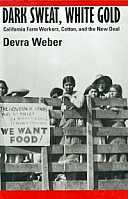 | Title: Dark sweat, white gold: California farm workers, cotton, and the New Deal Author: Weber, Devra 1946- Published: University of California Press, 1994 Subjects: History | Californian and Western History | Latino Studies | Labor Studies | California and the West | African History Publisher's Description: In her incisive analysis of the shaping of California's agricultural work force, Devra Weber shows how the cultural background of Mexican and, later, Anglo-American workers, combined with the structure of capitalist cotton production and New Deal politics, forging a new form of labor relations. She pays particular attention to Mexican field workers and their organized struggles, including the famous strikes of 1933.Weber's perceptive examination of the relationships between economic structure, human agency, and the state, as well as her discussions of the crucial role of women in both Mexican and Anglo working-class life, make her book a valuable contribution to labor, agriculture, Chicano, Mexican, and California history. [brief] Similar Items |
| 77. | 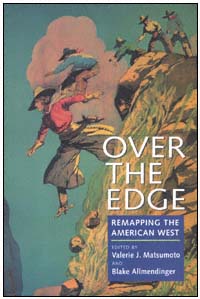 | Title: Over the edge: remapping the American West Author: Matsumoto, Valerie J Published: University of California Press, 1999 Subjects: American Studies | California and the West | Popular Culture | History | United States History | Californian and Western History | German Studies Publisher's Description: From the Gold Rush to rush hour, the history of the American West is fraught with diverse, subversive, and at times downright eccentric elements. This provocative volume challenges traditional readings of western history and literature, and redraws the boundaries of the American West with absorbing essays ranging widely on topics from tourism to immigration, from environmental battles to interethnic relations, and from law to film. Taken together, the essays reassess the contributions of a diverse and multicultural America to the West, as they link western issues to global frontiers.Featuring the latest work by some of the best new writers both inside and outside academia, the original essays in Over the Edge confront the traditional field of western American studies with a series of radical, speculative, and sometimes outrageous challenges. The collection reads the West through Ben-Hur and the films of Mae West; revises the western American literary canon to include the works of African American and Mexican American writers; examines the implications of miscegenation law and American Indian blood quantum requirements; and brings attention to the historical participation of Mexican and Japanese American women, Native American slaves, and Alaskan cannery workers in community life. [brief] Similar Items |
| 78. | 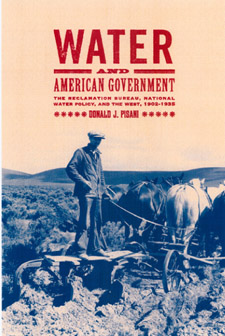 | Title: Water and American government: the Reclamation Bureau, national water policy, and the West, 1902-1935 Author: Pisani, Donald J Published: University of California Press, 2002 Subjects: History | United States History | Water | Public Policy | Geography | California and the West | Californian and Western History Publisher's Description: Donald Pisani's history of perhaps the boldest economic and social program ever undertaken in the United States--to reclaim and cultivate vast areas of previously unusable land across the country - shows in fascinating detail how ambitious government programs fall prey to the power of local interest groups and the federal system of governance itself. What began as the underwriting of a variety of projects to create family farms and farming communities had become by the 1930s a massive public works and regional development program, with an emphasis on the urban as much as on the rural West. [brief] Similar Items |
| 79. | 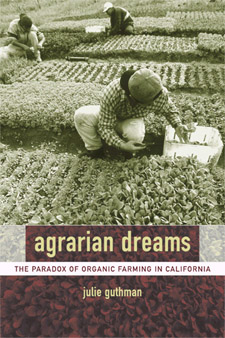 | Title: Agrarian dreams: the paradox of organic farming in California Author: Guthman, Julie Published: University of California Press, 2004 Subjects: Environmental Studies | California and the West | Public Policy | Social Science | Agriculture | Geography | Food and Cooking Publisher's Description: In an era of escalating food politics, many believe organic farming to be the agrarian answer. In this first comprehensive study of organic farming in California, Julie Guthman casts doubt on the current wisdom about organic food and agriculture, at least as it has evolved in the Golden State. Refuting popular portrayals of organic agriculture as a small-scale family farm endeavor in opposition to "industrial" agriculture, Guthman explains how organic farming has replicated what it set out to oppose. [brief] Similar Items |
| 80. | 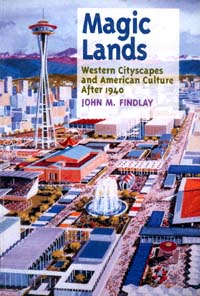 | Title: Magic lands: western cityscapes and American culture after 1940 Author: Findlay, John M 1955- Published: University of California Press, 1992 Subjects: History | United States History | California and the West | American Studies | Urban Studies | Californian and Western History Publisher's Description: The American West conjures up images of pastoral tranquility and wide open spaces, but by 1970 the Far West was the most urbanized section of the country. Exploring four intriguing cityscapes - Disneyland, Stanford Industrial Park, Sun City, and the 1962 Seattle World's Fair - John Findlay shows how each created a sense of cohesion and sustained people's belief in their superior urban environment. This first book-length study of the urban West after 1940 argues that Westerners deliberately tried to build cities that differed radically from their eastern counterparts.In 1954, Walt Disney began building the world's first theme park, using Hollywood's movie-making techniques. The creators of Stanford Industrial Park were more hesitant in their approach to a conceptually organized environment, but by the mid-1960s the Park was the nation's prototypical "research park" and the intellectual downtown for the high-technology region that became Silicon Valley.In 1960, on the outskirts of Phoenix, Del E. Webb built Sun City, the largest, most influential retirement community in the United States. Another innovative cityscape arose from the 1962 Seattle World's Fair and provided a futuristic, somewhat fanciful vision of modern life.These four became "magic lands" that provided an antidote to the apparent chaos of their respective urban milieus. Exemplars of a new lifestyle, they are landmarks on the changing cultural landscape of postwar America. [brief] Similar Items |